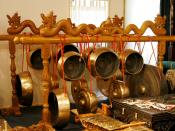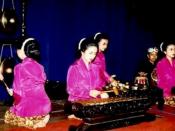The word gamelan simply means 'musical group' and may refer to 20 different kinds of xylophones, percussion-type music ansembles. Just as the Balinese share the planting of rice and the upkeep of their temples, traditional orchestra clubs, 'sekaha', are a communal organization in which everyone shares an equal interest and pride.
Scholars believe gamelan music may derive from the sound of priestly bells. Another theory holds that the percussive component of gamelan developed from workers using heavy pounding-poles to beat out music as they beat the husks off rice grains, perhaps lifting the trough off the ground and laying it on crossbeams to enhance the resonance.
The gamelan is likely indigenous to Indonesia and probably consisted of bamboo instruments. The royal courts of Bali emulated the pomp and ritual of the Javanese Majapahit Kingdom of ancient Java, and Balinese courtly music was no exception.
Mentioned of gamelan orchestras have been found in chronicles dating back as far as the 14th century.
With the Dutch seizure of power in 1908, Balinese court culture began to undergo a drastic transformation.
Their power and sources of revenues sharply curtailed, the 'puri' ceased to function as cultural centers. By the 1930s the ceremonial glitter of the courts had faded and most of the courts gamelan were in storage, gathering dust.
Unable to afford their traditional role as patrons of the arts, many courts sold their gamelan to village musicians, thus passing the domination and fostering of the arts into the hands of common villagers.
Whole orchestras were melted down and recast in forms that better suited the flamboyant and frolicsome tastes of the masses. From the moment the music left the courts and filtered into the villages, its development accelerated and took on a life of its own, becoming louder, faster, more earthy, and...


